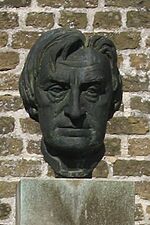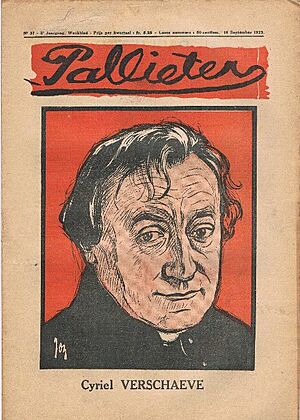Cyriel Verschaeve facts for kids
Quick facts for kids
Cyriel Verschaeve
|
|
|---|---|

Statue of Verschaeve in Alveringem
|
|
| Born | 30 April 1874 |
| Died | 8 November 1949 (aged 75) Solbad Hall, Tyrol, Allied-occupied Austria
|
| Occupation | Priest, writer, SS recruitment |
Cyriel Verschaeve (born April 30, 1874 – died November 8, 1949) was a priest and writer from Flanders, a region in Belgium. He was known for his strong Flemish nationalism, which means he believed Flanders should have more independence or even be its own country. During World War II, he supported the Nazis. Many people saw him as a spiritual leader for Flemish nationalists, but also as someone who spread Nazi ideas.
Contents
Early Life and Studies
Cyriel Verschaeve was born in Ardooie, a town in West Flanders, Belgium. He grew up in a Catholic family.
In 1886, when he was 12 years old, he began training to become a priest. He studied at the Minor Seminary, Roeselare. Later, in 1892, he moved to Bruges to finish his studies.
He became a priest in 1897. After that, he continued his education in Germany at the Friedrich Schiller University of Jena.
Becoming a Nationalist Leader
In 1911, Verschaeve returned to Belgium. He became a parish priest in Alveringem, a town in West Flanders. When World War I started, he became involved in the pacifist movement. Pacifists believe that all war is wrong and that disputes should be settled peacefully.
He also helped create the Frontbeweging. This was a Flemish group that wanted more independence for Flanders. It later became a political party called the Frontpartij.
Verschaeve, along with another leader named August Borms, believed that working with Germany might help Flanders achieve its goals. This was different from others in the movement who thought fighting for Belgium would be better.
In 1917, Verschaeve wrote an "Open Letter." In this letter, he asked for better rights for Flemish soldiers. He used strong words, even criticizing the king for not responding to an earlier letter. This showed a growing difference between the Belgian monarchy and some extreme Flemish nationalists.
In 1916, he became president of a group that wanted to build a memorial for Flemish soldiers. After the war, this dream came true with the Yser Tower memorial. Verschaeve helped lay the first stone for the tower on July 7, 1928.
Role in World War II
In 1939, Cyriel Verschaeve was dismissed from his role as chaplain. He had always admired Germany. In 1940, he wrote a book called Het Uur van Vlaanderen (The Hour of Flanders). In this book, he wrote about how some Flemish people felt sympathy for Nazi Germany. This was partly because he admired German culture, especially the music of Richard Wagner.
After Germany occupied Belgium, the Nazis appointed Verschaeve to a group dealing with Flemish culture. He also helped recruit people for the Flemish Legion in 1941. This legion was a military unit that fought alongside the German army.
Verschaeve strongly believed that the Soviet Union (a large communist country) was a great danger to Europe. He was very anti-communist and supported Nazism. In 1944, he met with Heinrich Himmler, a very powerful Nazi leader. They discussed the Flemish question, but not much came of it because the Allied forces were close to liberating Belgium.
At this meeting, Verschaeve told Himmler that he did not agree with the Nazi idea of paganism (worshipping many gods). However, he thought Nazism could work with the Church's message if it stayed focused on politics and action. Until the Allies successfully pushed back the Nazi army in Belgium, Verschaeve kept asking young Flemish Catholic boys to join the Waffen-SS (a Nazi military group) to fight against the Soviet Union and what he called "Satanic Bolshevism" (another term for communism).
Later Life and Legacy
In 1945, as the war ended, Cyriel Verschaeve fled to Austria. A Belgian court found him guilty while he was away. He lived in Austria until 1949, when he died of a heart attack in Solbad Hall. He was buried there.
In 1973, members of a group called the Vlaamse Militanten Orde dug up his remains. They reburied them in Flanders.
Today, Verschaeve remains a controversial figure. Some extreme Flemish nationalists still admire him. However, many French-speaking Catholics see him as a symbol of disgraceful Flemish nationalism because of his support for the Nazis.
Some streets in Belgian towns like Kortrijk, Lanaken, and Breendonk were once named after him. However, between 2019 and 2020, the local councils decided to change those street names.
Writing
Cyriel Verschaeve wrote many works on philosophy. His writing style was often dramatic and poetic. He was also known as a poet and a writer of plays. Two of his plays, Judas (1919) and Maria-Magdalena (1930), are considered his best works.


